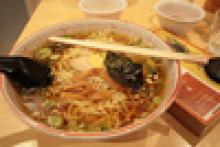The New York Times has a mouthwatering Frugal Traveler article about "Tokyo's sprawling ramen ecosystem." Although we here in the States are used to ramen as a ridiculously cheap, dried foodstuff, ramen is serious business in Japan. As Frugal Traveler Matt Gross says, Tokyo's ramen stands and restaurants serve ramen where "everything is fresh, handmade and artisanal."
I learned a lot about ramen and Tokyo from this article. (Among other things, I learned not to read articles about "real" ramen at lunchtime. I finally broke down and fixed up a packet of Top Ramen, but it just wasn't the same.) Many ramen shops specialize in just one kind of ramen. For example, one restaurant specializes in green curry ramen, another in tonkotsu (a milky pork broth).
The ramen experience varies greatly, from literal holes in the wall to high end chef showcase restaurants. At most middle of the road ramen shops, you buy a ticket at a vending machine and exchange that for your meal, which you eat at the stainless steel counter.
One of the more unexpected facts: ramen has a "stereotypically masculine image," even spawning a book aimed at women who want more feminine (or less resolutely masculine) ramen shops. I can't think of an American equivalent, although barbecue probably comes close.
Some Japanese think of ramen as a food that connects them to their roots. Japanese hipsters eat it because knowing which ramen shop is hot is a badge of cool.
If like me you live a little ways away from a ramen specialty restaurant, and want to make your own, ramen has three parts: the noodles, the broth, and the add-ins. There is a bewildering variety available in all three (thus the proliferation of ramen restaurants and specialties in Tokyo).
Although the noodle used in Japanese ramen is called "ramen noodles," I have not had any luck finding these here in the States. You can buy a packet of instant ramen and just use those noodles, of course. But for something a little more appetizing, use a package of udon noodles. Udon noodles are widely available in most parts of the country - my local Safeway even carries them.
The soup broth is usually based on chicken or pork, along with something else as a flavoring. A carton of chicken broth will work well as a starting point. (I prefer Swanson's organic homestyle chicken broth for this kind of thing. It costs more, but tastes less institutional compared to their "regular" chicken broth.)
The most common flavorings added to broth are seaweed flakes, dried bonito flakes, sardines, mushroom, or onions. Typically you would choose one from that list, and use a light touch! Next, add a dash of miso or soy sauce to give the broth that full flavor.
As for toppings, use whatever is freshest and close to hand. Traditional toppings include slivers of fresh carrot, thin slices of meat, cubes of tofu, cooked shrimp, finely sliced fresh spinach, bean sprouts, thin slices of scallions or green onions. You can build from there, adding just about anything that strikes your fancy!
I learned a lot about ramen and Tokyo from this article. (Among other things, I learned not to read articles about "real" ramen at lunchtime. I finally broke down and fixed up a packet of Top Ramen, but it just wasn't the same.) Many ramen shops specialize in just one kind of ramen. For example, one restaurant specializes in green curry ramen, another in tonkotsu (a milky pork broth).
The ramen experience varies greatly, from literal holes in the wall to high end chef showcase restaurants. At most middle of the road ramen shops, you buy a ticket at a vending machine and exchange that for your meal, which you eat at the stainless steel counter.
One of the more unexpected facts: ramen has a "stereotypically masculine image," even spawning a book aimed at women who want more feminine (or less resolutely masculine) ramen shops. I can't think of an American equivalent, although barbecue probably comes close.
Some Japanese think of ramen as a food that connects them to their roots. Japanese hipsters eat it because knowing which ramen shop is hot is a badge of cool.
If like me you live a little ways away from a ramen specialty restaurant, and want to make your own, ramen has three parts: the noodles, the broth, and the add-ins. There is a bewildering variety available in all three (thus the proliferation of ramen restaurants and specialties in Tokyo).
Although the noodle used in Japanese ramen is called "ramen noodles," I have not had any luck finding these here in the States. You can buy a packet of instant ramen and just use those noodles, of course. But for something a little more appetizing, use a package of udon noodles. Udon noodles are widely available in most parts of the country - my local Safeway even carries them.
The soup broth is usually based on chicken or pork, along with something else as a flavoring. A carton of chicken broth will work well as a starting point. (I prefer Swanson's organic homestyle chicken broth for this kind of thing. It costs more, but tastes less institutional compared to their "regular" chicken broth.)
The most common flavorings added to broth are seaweed flakes, dried bonito flakes, sardines, mushroom, or onions. Typically you would choose one from that list, and use a light touch! Next, add a dash of miso or soy sauce to give the broth that full flavor.
As for toppings, use whatever is freshest and close to hand. Traditional toppings include slivers of fresh carrot, thin slices of meat, cubes of tofu, cooked shrimp, finely sliced fresh spinach, bean sprouts, thin slices of scallions or green onions. You can build from there, adding just about anything that strikes your fancy!
Creative Commons-licensed photo courtesy of Flickr user lets-jam
